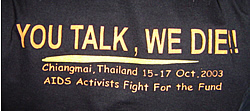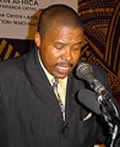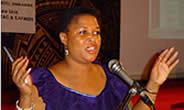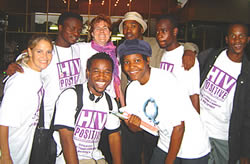|
Back to Index
Report
on the (PATAM) Conference held in Harare, Zimbabwe – 3-5 March 2004
Kubatana.net
March
08, 2004
Background
on PATAM
  PATAM
is the acronym for the Pan African HIV/AIDS Treatment Action Movement,
which was formed in Cape Town, South Africa in August 2002. PATAM
is a social movement of over 80 individuals from 21 African countries
who are dedicated to mobilising communities, political leaders,
and all sectors of society to ensure access to anti-retroviral (ARV)
treatment for all people infected with HIV/AIDS in Africa. PATAM
is the acronym for the Pan African HIV/AIDS Treatment Action Movement,
which was formed in Cape Town, South Africa in August 2002. PATAM
is a social movement of over 80 individuals from 21 African countries
who are dedicated to mobilising communities, political leaders,
and all sectors of society to ensure access to anti-retroviral (ARV)
treatment for all people infected with HIV/AIDS in Africa.
  Introduction Introduction
The Harare PATAM Conference is the first regional conference
and the theme of the conference was Scaling up Access to Treatment
in Southern Africa; a way forward. The Conference was hosted
by the Treatment Action Campaign (TAC) of South Africa, Zimbabwe
Activists on HIV and AIDS (ZAHA), Southern African HIV/AIDS Information
Dissemination Service (SAFAIDS)
and The Centre. The main objective of the conference was to provide
at platform for activists throughout Africa to review some of the
challenges and strategies they face in ensuring the universal access
to anti-retroviral therapy and other essential services. The conference
was also meant to share ideas and experiences of what has worked
and what has not worked. Over 150 delegates from across Southern
Africa were represented.
The Conference
began with the observation of a minute of silence, in respect of
all the people who had died because of the AIDS scourge.
The Permanent Secretary in the Ministry of Health and Child Welfare,
Dr Elizabeth Xaba was scheduled to officially open the conference.
However, she was not able to attend due other commitments, the delegates
were told. However, some delegates felt that her absence and failure
to send a representative to the conference was an indication of
how uncaring the government was regards the plight of people infected
with HIV/AIDS. In actual fact there was no single government representative.
The delegates felt that the government was shunning them and their
absence was a clear indication.
  Bishop
Trevor Manhanga officially opened the conference. In his speech
Bishop Manhanga said he was not surprised that the conference was
bereft of government representation. He informed the delegates that,
"any government in Africa that does not make HIV/AIDS a priority
must be voted out". He sighted a lack of concern and respect from
the African leaders and gave an example of the absence of African
leaders at the 1999 World Conference on AIDS held in Lusaka, Zambia-not
even the President of Zambia?" Bishop Manhanga urged the activists
to make HIV/AIDS an election issue and that " No government should
be elected that does not have a solid workable plan on treatment
for HIV/AIDS sufferers." Bishop
Trevor Manhanga officially opened the conference. In his speech
Bishop Manhanga said he was not surprised that the conference was
bereft of government representation. He informed the delegates that,
"any government in Africa that does not make HIV/AIDS a priority
must be voted out". He sighted a lack of concern and respect from
the African leaders and gave an example of the absence of African
leaders at the 1999 World Conference on AIDS held in Lusaka, Zambia-not
even the President of Zambia?" Bishop Manhanga urged the activists
to make HIV/AIDS an election issue and that " No government should
be elected that does not have a solid workable plan on treatment
for HIV/AIDS sufferers."
  There
were a good number of presentations and parallel workshops during
the 3-day conference. One of the Aids activists at the conference
was Chantinkha Nkhoma from Malawi, she facilitated the "creating
an environment for openness". From the discussions that involved
great participation from the participants, the major problem of
people not being able to open up about their status was due to the
stigma and discrimination. People living with AIDS are shunned by
society as they are viewed to immoral, said one participant. There
were a good number of presentations and parallel workshops during
the 3-day conference. One of the Aids activists at the conference
was Chantinkha Nkhoma from Malawi, she facilitated the "creating
an environment for openness". From the discussions that involved
great participation from the participants, the major problem of
people not being able to open up about their status was due to the
stigma and discrimination. People living with AIDS are shunned by
society as they are viewed to immoral, said one participant.
It was generally
agreed that there should be incentives for people who disclose their
status. For example they should have access to counselling and access
to medicines. Participants also concurred that there was need to
increase treatment literacy to the general public and to people
who are also living with HIV/AIDS.
The role of
the media was also under the spotlight. Luckson Chipare, Director
of the Media Institute of Southern Africa facilitated the session.
Participants in this session agreed that there was a need for the
Media especially journalists to have joint training workshops with
people living with AIDS. Most of the workshops that were meant to
create awareness amongst journalists did not seem to be yielding
any results. The joint workshops are meant to create an understanding
between the journalists and people living with AIDS. The training
workshops are also meant to be a platform for people to network
with the media. People living with HIV/AIDS were urged to write
their own stories for publication in the media once solid contacts
have been created with the media.
  One
of the presentations that were made was the 3 by 5 initiative:
Implications for Zimbabwe. Dr Francis Onyango from World Health
Organisation made the presentation. According to Dr Onyango’s presentation,
the 3 by 5 is a commitment of placing 3 million people lobbying
with HIV/AIDS by the end of 2005. With reference to Zimbabwe, the
3 by 5 initiative is meant to provide treatment to about 260 000
people living with HIV/AIDS by 2005. One of the major implications
of the 3 by 5 for Zimbabwe is the Human Resource factor. For 3 by
5 to be effective in Zimbabwe there is a need for resource people,
like doctor’s and nurses whom will help monitor the initiative.
Zimbabwe has been experiencing a large labour turnover in the health
sector and this is likely to affect the effectiveness of the 3 by
5 initiative. One
of the presentations that were made was the 3 by 5 initiative:
Implications for Zimbabwe. Dr Francis Onyango from World Health
Organisation made the presentation. According to Dr Onyango’s presentation,
the 3 by 5 is a commitment of placing 3 million people lobbying
with HIV/AIDS by the end of 2005. With reference to Zimbabwe, the
3 by 5 initiative is meant to provide treatment to about 260 000
people living with HIV/AIDS by 2005. One of the major implications
of the 3 by 5 for Zimbabwe is the Human Resource factor. For 3 by
5 to be effective in Zimbabwe there is a need for resource people,
like doctor’s and nurses whom will help monitor the initiative.
Zimbabwe has been experiencing a large labour turnover in the health
sector and this is likely to affect the effectiveness of the 3 by
5 initiative.
Dr CE Ndlovu
also presented an overview of ARV treatment in Zimbabwe. Dr Ndlovu
said for ARV treatment to be effective in Zimbabwe there was need
to train health workers in HIV management, reduce the dependency
on doctors to manage AIDS and to delegate some aspects of HIV/AIDS
care to non doctors and non-health professionals. For example, there
is a need to share the counselling burden with non-medical people.
Dr Ndlovu also presented on the progress that had been achieved
in the ARV treatment. Amongst some of the achievements is the National
medical reference laboratory at Harare hospital was now equipped
to perform CD4 counts, viral loads and resistance testing.
Vulnerable Groups
and Access to Treatment was also one of the joint presentations
by Keith Goddard of the Gays and Lesbians of Zimbabwe (GALZ)
together with David Fuamba from the Refugee Relief and Development
Association in Cape Town, South Africa. David and Keith highlighted
that some of the groups are vulnerable because on many reasons some
which include poverty, culture, civil and political unrest and victim
mentalities that they express. In an effort to avoid the vulnerable
being the targets it was highlighted that there was need for developing
strategies and action plans, monitoring progress of activities and
ensuring the visibility of vulnerable groups in all campaigning.
  One
of the delegates who were expected to attend the Conference was
Zackie Achmat. He was however not able to make the trip to Harare
due to ill health. Zackie is on the forefront in the campaigning
for wider access to treatment for the people of South Africa. Zackie
has been living with HIV/AIDS for more than 10 years and has refused
to take ARV’s until they are made available to everyone. Zackie
set up the Treatment Action Campaign which is involved in the fight
to ensure that people living with HIV/AIDS in South Africa have
access to the ARV’s. Zackie has won numerous awards for his activism
campaign and has been nominated for the 2004 Nobel Peace Prize. One
of the delegates who were expected to attend the Conference was
Zackie Achmat. He was however not able to make the trip to Harare
due to ill health. Zackie is on the forefront in the campaigning
for wider access to treatment for the people of South Africa. Zackie
has been living with HIV/AIDS for more than 10 years and has refused
to take ARV’s until they are made available to everyone. Zackie
set up the Treatment Action Campaign which is involved in the fight
to ensure that people living with HIV/AIDS in South Africa have
access to the ARV’s. Zackie has won numerous awards for his activism
campaign and has been nominated for the 2004 Nobel Peace Prize.
Conclusion
  The
PATAM Conference was meant come up with strategies that would enable
regional countries to speak with one voice on the issue of having
access to cheaper drug prices and in helping create awareness on
the people’s health campaign. A list of 6 working groups was created
and these were tasked with coming up with strategies that could
be used in the access to treatment campaigns. The
PATAM Conference was meant come up with strategies that would enable
regional countries to speak with one voice on the issue of having
access to cheaper drug prices and in helping create awareness on
the people’s health campaign. A list of 6 working groups was created
and these were tasked with coming up with strategies that could
be used in the access to treatment campaigns.
In her closing
remarks, Lois Lunga Executive director of Safaids advised all AIDS
activists to use the election platform to lobby HIV/AIDS onto the
political agenda.
Njogu Morgan,
the international Co-ordinator for the Treatment Action Campaign
thanked all present for their support and contributions. He then
asked for a minute of silence as a tribute to those who had lost
their lives due to the AIDS scourge.
Please credit www.kubatana.net if you make use of material from this website.
This work is licensed under a Creative Commons License unless stated otherwise.
TOP
|

